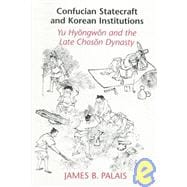
What is included with this book?
| Acknowledgments | vii | ||||
| Introduction | 3 | (22) | |||
| PART I. THE EARLY CHOSON DYNASTY, 1392-1650 | 25 | (90) | |||
|
25 | (36) | |||
|
61 | (31) | |||
|
92 | (23) | |||
| PART II. SOCIAL REFORM: YANGBAN AND SLAVES | 115 | (160) | |||
| Introduction | 115 | (7) | |||
|
122 | (48) | |||
|
170 | (38) | |||
|
208 | (63) | |||
|
271 | (4) | |||
| PART III. LAND REFORM | 275 | (116) | |||
| Introduction | 275 | (2) | |||
|
277 | (36) | |||
|
313 | (41) | |||
|
354 | (30) | |||
|
384 | (7) | |||
| PART IV. MILITARY REFORM | 391 | (188) | |||
| Introduction | 391 | (3) | |||
|
394 | (48) | |||
|
442 | (27) | |||
|
469 | (32) | |||
|
501 | (36) | |||
|
537 | (32) | |||
|
569 | (10) | |||
| PART V. REFORM OF GOVERNMENT ORGANIZATION | 579 | (190) | |||
| Introduction | 579 | (2) | |||
|
581 | (31) | |||
|
612 | (34) | |||
|
646 | (27) | |||
|
673 | (32) | |||
|
705 | (30) | |||
|
735 | (27) | |||
|
762 | (7) | |||
| PART VI. FINANCIAL REFORM AND THE ECONOMY | 769 | (233) | |||
| Introduction | 769 | (2) | |||
|
771 | (44) | |||
|
815 | (40) | |||
|
855 | (22) | |||
|
877 | (47) | |||
|
924 | (40) | |||
|
964 | (35) | |||
|
999 | (3) | |||
| Epilogue: The Complexities of Korean Confucian Statecraft | 1002 | (18) | |||
| Notes | 1020 | (133) | |||
| Glossary | 1153 | (40) | |||
| List of Kings of the Choson Dynasty | 1193 | (2) | |||
| List of Names | 1195 | (9) | |||
| Bibliography | 1204 | (27) | |||
| Index | 1231 |
The New copy of this book will include any supplemental materials advertised. Please check the title of the book to determine if it should include any access cards, study guides, lab manuals, CDs, etc.
The Used, Rental and eBook copies of this book are not guaranteed to include any supplemental materials. Typically, only the book itself is included. This is true even if the title states it includes any access cards, study guides, lab manuals, CDs, etc.